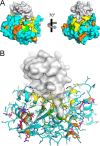Discovery and engineering of enhanced SUMO protease enzymes
- PMID: 29976752
- PMCID: PMC6109922
- DOI: 10.1074/jbc.RA118.004146
Discovery and engineering of enhanced SUMO protease enzymes
Abstract
Small ubiquitin-like modifier (SUMO) is commonly used as a protein fusion domain to facilitate expression and purification of recombinant proteins, and a SUMO-specific protease is then used to remove SUMO from these proteins. Although this protease is highly specific, its limited solubility and stability hamper its utility as an in vitro reagent. Here, we report improved SUMO protease enzymes obtained via two approaches. First, we developed a computational method and used it to re-engineer WT Ulp1 from Saccharomyces cerevisiae to improve protein solubility. Second, we discovered an improved SUMO protease via genomic mining of the thermophilic fungus Chaetomium thermophilum, as proteins from thermophilic organisms are commonly employed as reagent enzymes. Following expression in Escherichia coli, we found that these re-engineered enzymes can be more thermostable and up to 12 times more soluble, all while retaining WT-or-better levels of SUMO protease activity. The computational method we developed to design solubility-enhancing substitutions is based on the RosettaScripts application for the macromolecular modeling suite Rosetta, and it is broadly applicable for the improvement of solution properties of other proteins. Moreover, we determined the X-ray crystal structure of a SUMO protease from C. thermophilum to 1.44 Å resolution. This structure revealed that this enzyme exhibits structural and functional conservation with the S. cerevisiae SUMO protease, despite exhibiting only 28% sequence identity. In summary, by re-engineering the Ulp1 protease and discovering a SUMO protease from C. thermophilum, we have obtained proteases that are more soluble, more thermostable, and more efficient than the current commercially available Ulp1 enzyme.
Keywords: Rosetta; cysteine protease; enzyme kinetics; fusion protein; protein design; protein engineering; protein purification; protein solubility; small ubiquitin-like modifier (SUMO); thermostability.
© 2018 Lau et al.
Conflict of interest statement
C. D. L. holds a patent for a rapidly cleavable SUMO fusion protein expression system for difficult to express proteins
Figures






Similar articles
-
A Novel Strategy for the Preparation of Codon-Optimized Truncated Ulp1 and its Simplified Application to Cleavage the SUMO Fusion Protein.Protein J. 2016 Apr;35(2):115-23. doi: 10.1007/s10930-016-9654-1. Protein J. 2016. PMID: 26960810 Free PMC article.
-
Tandem SUMO fusion vectors for improving soluble protein expression and purification.Protein Expr Purif. 2015 Dec;116:42-9. doi: 10.1016/j.pep.2015.08.019. Epub 2015 Aug 20. Protein Expr Purif. 2015. PMID: 26297996
-
A novel approach for production of an active N-terminally truncated Ulp1 (SUMO protease 1) catalytic domain from Escherichia coli inclusion bodies.Protein Expr Purif. 2020 Feb;166:105507. doi: 10.1016/j.pep.2019.105507. Epub 2019 Oct 4. Protein Expr Purif. 2020. PMID: 31586598
-
SUMO-specific proteases: a twist in the tail.Trends Cell Biol. 2007 Aug;17(8):370-6. doi: 10.1016/j.tcb.2007.08.002. Epub 2007 Sep 4. Trends Cell Biol. 2007. PMID: 17768054 Review.
-
Function and regulation of SUMO proteases.Nat Rev Mol Cell Biol. 2012 Dec;13(12):755-66. doi: 10.1038/nrm3478. Nat Rev Mol Cell Biol. 2012. PMID: 23175280 Free PMC article. Review.
Cited by
-
Structural characterization and computational analysis of PDZ domains in Monosiga brevicollis.Protein Sci. 2020 Nov;29(11):2226-2244. doi: 10.1002/pro.3947. Epub 2020 Sep 25. Protein Sci. 2020. PMID: 32914530 Free PMC article.
-
Structure of TnsABCD transpososome reveals mechanisms of targeted DNA transposition.Cell. 2024 Nov 27;187(24):6865-6881.e16. doi: 10.1016/j.cell.2024.09.023. Epub 2024 Oct 8. Cell. 2024. PMID: 39383864
-
Fusion crystallization reveals the behavior of both the 1TEL crystallization chaperone and the TNK1 UBA domain.Structure. 2023 Dec 7;31(12):1589-1603.e6. doi: 10.1016/j.str.2023.09.001. Epub 2023 Sep 29. Structure. 2023. PMID: 37776857 Free PMC article.
-
Investigating Complexin-Membrane Interactions Using NMR and Optical Methods.Methods Mol Biol. 2025;2887:17-52. doi: 10.1007/978-1-0716-4314-3_2. Methods Mol Biol. 2025. PMID: 39806144
-
Trim-Away ubiquitinates and degrades lysine-less and N-terminally acetylated substrates.Nat Commun. 2023 Apr 15;14(1):2160. doi: 10.1038/s41467-023-37504-x. Nat Commun. 2023. PMID: 37061529 Free PMC article.
References
-
- Lima C. D., and Mossessova E. (March 22, 2011) Rapidly cleavable sumo fusion protein expression system for difficult to express proteins. U. S. Patent US7910364B2
Publication types
MeSH terms
Substances
Associated data
- Actions
- Actions
Grants and funding
LinkOut - more resources
Full Text Sources
Other Literature Sources
Molecular Biology Databases
Research Materials

